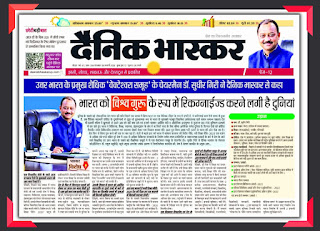EDUCATION IN RURAL AREAS SIGNIFICANT FOR INDIA’S DEVELOPMENT
Rural education has become a
significantly vital aspect of every economy.
In India, rural education plays an
even major role as the rural economy contributes to 25-30% of the country’s
GDP.
Therefore, literacy in these parts
is essential for the growth of the Indian economy.
Education is important for
everybody, be it learning new skills, facts, or trades.
The opportunity to learn always
benefits a person as it increases employability options, & also gives
knowledge about healthcare and hygiene.
It helps one decipher between wrong
and right and also facilitates their and their future generation’s holistic
growth.
Many reforms and policies are there
for promoting education in the developed parts and cities of India, like the
metropolitan cities and nearby areas.
However, the rural communities that
makeup such a huge percentage of the Indian economy need major educational
promotion, reforms, and policies.
Dr. Sudhir Giri, a business prodigy,
set up Shri Venkateshwara University in the rural area of Uttar Pradesh;
Gajraula with the vision to “Take Education Towards the Rural Areas”.
Sir observed and keenly studies the
demographics of the area. There were no good educational institutions around
the area, and most of the good colleges or institutes were at a distance from
the habitats of the locals.
This motivated him to set up a fully
equipped university, medical college, and a hospital in the nearby range so
that young adults did not have to move to urban areas for gaining higher
education.
Educating communities involves
building schools and educating children, young adults, and even elders.
This would foster rural communities
heading towards a healthier and brighter future.
A strong education system in rural
communities can strengthen the rural populace as it teaches them to make
informed decisions about their farms and also trains them to implement
technology in agricultural practices.
Education also enables individuals
to learn of their fundamental rights and stay informed about various reforms,
policies, and schemes made by the government for their betterment, so that they
can make use of these facilities.
According to a report, the number of
kids who haven’t attended school in India is probably over ninety million, and
rural India forms an overwhelming majority of this figure.
These terribly shocking digits seem
even worse when we know that school-going boys form a much higher percentage of
children in rural India gaining a high-school diploma, whereas the girl child
is deprived of basic education.
What’s even more disturbing is that
more than half of the students in class 5th cannot read a textbook from class
2nd or 3rd. They barely even know how to solve elementary mathematical problems.
Some of the major problems faced by
students in rural areas are:
1. Lack of quality education: First, there is a lack of colleges and
universities in rural areas, even if there are, they lack quality education,
and many courses are not even a part of the curriculum.
These institutes don’t have
laboratories, libraries, or other facilities necessary for technical courses
like engineering and medical sciences.
2. Scarcity of excellent teachers: Institutes set up in the lesser
developed areas do not have a skilled teaching force that results in lower
teaching standards.
3. Financial aspects: A majority of students belonging to rural areas
are not financially very strong.
Therefore, many youngsters don’t
even think of gaining higher education, they directly start working after
finishing basic schooling.
Their families find it useless to
send their kids to cities, as the living expenses and exorbitant fees are
impossible for them to pay.
4. Social factors: In rural areas, even to date, girls and women cannot
move to urban areas to receive higher education.
It is a major challenge faced by
women and this results in negligible or no higher education for women living in
rural areas.
Apart from the above problems,
there are many other hurdles that people in rural areas have to face.
The government, however, is taking
various measures and making more and more policies for the promotion of proper
education in India. For the betterment of rural education, we should also take
these factors into consideration:
1. Good use of technology: Technology will help reduce costs in
education and increase convenience. It will also help children learn computer
skills, which are a vital part of primary and higher education.
Schools can also impart e-learning
software systems that offer an all-in-one learning experience and guarantee
quality education, like the urban cities.
2. We should set up more schools: Many more schools need to be set up
near rural areas, as a major part of India comprises rural areas.
Setting up excellent schools would
also help parents impart excellent education to their children without having
to worry about transportation costs.
3. Quality teaching force: Qualified and skilled teaching force should
handle primary and higher education. Teachers should avoid absenteeism and
ensure that students get a quality education without relocating to other parts
of the country.
India has a huge youth population
and if these youths get the correct guidance and education at the right time
and age, it would facilitate the development of the nation




Comments
Post a Comment